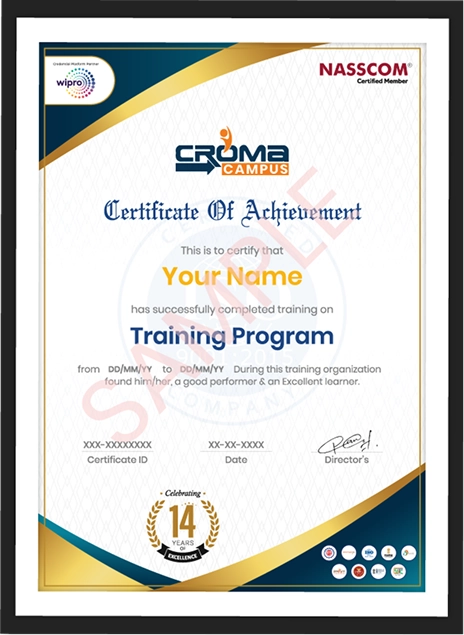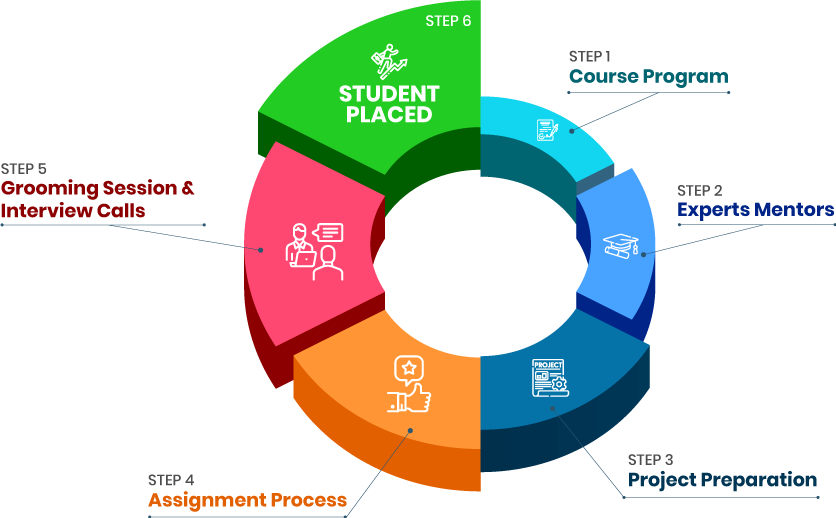- 2 Live Project
- Self-Paced/ Classroom
- Certification Pass Guaranteed
Course Offered By
HTML/CSS: HTML is like the foundation of a building, it gives websites their structure by organizing content. CSS is the designer, adding style, color, and layout to bring the site to life. Together, they ensure websites look amazing and function well on any screen, whether its your phone or laptop. Without HTML and CSS, the web would be a very boring location.
JavaScript: JavaScript is the magic behind a websites interactivity. It makes buttons clickable, forms responsive, and pages dynamic. Whether youre building animations, validating forms, or creating interactive elements, JavaScript is the language that makes websites come alive. Full-stack developers rely on JavaScript to handle both front-end and back-end development, making it a core language for modern web applications.
React.js: React.js helps developers create smooth, fast websites by breaking down the interface into reusable pieces, like building with LEGO blocks. It ensures that your websites components can be quickly updated without refreshing the entire page. React is perfect for creating modern, dynamic web apps where users expect a seamless, responsive experience. Its component-based architecture also makes scaling apps easier as they grow.
Node.js: Node.js lets developers use JavaScript for the server side, which means they can build the back-end and front-end of an app using the same language. This helps create fast, scalable applications like real-time chat or streaming services. With Node.js, developers handle concurrent connections easily, which is why it's so popular for high-traffic apps like social media platforms.
Express.js: Express.js simplifies the backend of web apps by providing tools for handling requests, routes, and server logic. It works with Node.js to help full-stack developers create fast, scalable web applications. Express reduces the amount of boilerplate code, so developers can focus more on building the features that matter. Its lightweight design makes it highly flexible, giving developers control over the architecture of their apps.
MongoDB: MongoDB is a database designed to store data in flexible, easy-to-access documents. Instead of rigid tables, it uses a more flexible format, allowing developers to handle complex data types. This makes it ideal for apps that deal with large amounts of real-time data. Its NoSQL structure is especially suited for modern applications that require dynamic and fast-changing data, such as social media or e-commerce platforms.
SQL: SQL is like the librarian of databases, it helps store, organize, and retrieve structured data. Full-stack developers use SQL to interact with relational databases, where data is neatly stored in tables. Its essential for applications that require secure, accurate data storage, such as e-commerce sites, banking apps, or any app that manages complex, interconnected data. SQL ensures that data can be easily queried and updated with precision.
Git: Git is a tool that lets developers track changes in their code, like a digital time machine. It helps teams collaborate without overwriting each others work. Developers can branch off, experiment, and then merge their changes back into the main project. Git provides version control for both individual developers and large teams, ensuring smooth project management throughout development cycles.
GitHub/GitLab: GitHub and GitLab are platforms where developers store and share their Git repositories. These tools help teams collaborate more effectively, allowing them to review code, track issues, and automate testing. Full-stack developers rely on GitHub and GitLab for version control and team collaboration, ensuring their projects are well-organized and easy to manage, even with multiple contributors. They also offer hosting for project documentation and continuous integration pipelines.
Docker: Docker helps developers package applications into containers, which are like portable environments that ensure code runs the same everywhere. This makes deploying apps faster and more reliable. Full-stack developers use Docker to simplify app development, ensuring that the software works consistently across different systems, from development to production. Docker also allows applications to be scaled easily by running multiple containers.
Nginx: Nginx is a powerful web server that helps websites handle large amounts of traffic efficiently. Full-stack developers use Nginx to distribute incoming web traffic, serving multiple users at once without slowing down. Its great for high-traffic websites, acting as a gatekeeper to balance the load and ensure smooth performance for users. Nginx can also function as a reverse proxy, improving security and scalability for modern web applications.
Postman: Postman is a tool that helps developers test APIs by sending requests and checking responses. Its like a communication tester between the front-end and back-end. Full-stack developers use Postman to make sure their API endpoints work correctly, ensuring that the front-end communicates seamlessly with the back-end services in their applications. Its also widely used for automating and organizing API tests in larger projects.
Webpack: Webpack is a tool that bundles all of a web applications files into one efficient package. It helps optimize things like JavaScript, CSS, and images so the site loads faster. Full-stack developers use Webpack to streamline their code, ensuring that their apps run smoothly and efficiently, even when dealing with lots of different assets. Its modular approach allows for better performance and easier management of large-scale apps.
Babel: Babel ensures that your fancy new JavaScript code works on older browsers. It converts modern JavaScript into a version that older systems can understand. Full-stack developers use Babel to ensure their web apps are compatible across all browsers, ensuring users have the best experience no matter what device theyre using. Its especially important in teams that need to support a wide variety of browsers or legacy systems.
Jest: Jest is a tool for testing JavaScript code to make sure everything works as it should. It helps full-stack developers find bugs before the code goes live. With Jest, developers can run unit tests on both the front-end and back-end, ensuring that their applications perform correctly under different conditions. Jests user-friendly interface makes writing and running tests straightforward, speeding up the development process.
AWS/Azure/Google Cloud: AWS, Azure, and Google Cloud are cloud platforms that offer services like storage, databases, and virtual machines. Full-stack developers use these services to host and scale web applications, ensuring their apps can handle high traffic and large amounts of data without breaking a sweat, while only paying for what they use. These platforms offer extensive tools for everything from AI to container management.
RESTful APIs: RESTful APIs allow communication between different systems, letting the front-end and back-end talk to each other. Full-stack developers use REST to make sure data flows smoothly between different parts of an app. REST is simple, scalable, and easy to integrate, making it ideal for modern web applications. Its stateless nature makes it highly efficient for web services.
GraphQL: GraphQL lets developers request specific data from APIs, making data fetching more efficient. Unlike REST, where you might get more data than you need, GraphQL allows you to ask for exactly what you want. Full-stack developers use GraphQL to optimize data delivery, improving performance, especially for apps with complex data requirements. This fine-tuned approach can reduce server load and enhance application responsiveness.
Bootstrap/Tailwind CSS: Bootstrap and Tailwind CSS are frameworks that make it easier to design responsive, mobile-friendly websites. Bootstrap offers pre-made components, while Tailwind provides a more flexible, utility-based approach. Full-stack developers use them to quickly style websites, ensuring consistency and reducing the time it takes to develop polished designs. Both frameworks enhance user experience by providing responsive layouts and beautiful interfaces with minimal effort.
Redux: Redux is a state management tool often used with React to handle the data flow in large applications. It keeps track of an apps entire state in one central location, making data management predictable and easier to debug. Full-stack developers use Redux to ensure their apps run smoothly, especially when scaling. Its unidirectional data flow simplifies app architecture, making code more maintainable over time.
Front-End Developer:
Back-End Developer:
Full Stack Engineer:
Web Developer:
Mobile App Developer:
DevOps Engineer:
UI/UX Developer:
Software Engineer:
MEAN Stack Developer:
MERN Stack Developer:
Cloud Developer:
Java Full Stack Developer:
Python Full Stack Developer:
Ruby Full Stack Developer:
.NET Full Stack Developer:
LAMP Stack Developer:
Technical Architect:
API Developer:
Database Administrator (DBA):
Software Consultant:
HTML/CSS: These are the foundation of web development and are useful for structuring and styling web pages. Along with this, HTML defines the content, while CSS controls the appearance.
JavaScript: This is the programming language of the web and it helps in adding interactivity and dynamic elements to web pages.Along with this, it helps in handling user input, manipulating the DOM, and making AJAX requests.
React: It is a popular JavaScript library useful for building user interfaces. Along with this, it also uses a component-based architecture useful for efficient rendering and reusability. Moreover, it comes with its virtual DOM and declarative syntax.
Angular: This is a comprehensive JavaScript framework for building web applications. Along with this, using it provides you with a suite of features, including routing, state management, and dependency injection.
Vue.js: This refers to a progressive JavaScript framework that is lightweight and easy to learn. Furthermore, it offers businesses with a flexible and modular approach to building user interfaces.
Node.js: It refers to a popular JavaScript runtime environment for server-side development. Along with this, Node JS helps businesses in building scalable and efficient web applications using JavaScript.
Python: This is a popular and versatile programming language often used for back-end development. It includes various popular frameworks including Django and Flask. Furthermore, it also offers a large community and extensive libraries.
Ruby on Rails: It refers to a popular full-stack web application framework written in Ruby. Furthermore, it is well known for its convention over configuration approach and rapid development. Along with this, it is also popular for building web applications with productivity.
Java: This is a popular and robust versatile programming language useful for enterprise-level applications. Along with this, it is useful for developing various popular frameworks including Spring Boot and Hibernate. It provides strong type safety and a large ecosystem of libraries.
Spring Boot: It refers to a popular Java framework for building microservices and web applications. Along with this, it provides businesses with a quick start for developing Spring-based applications. Moreover, it offers various features such as auto-configuration and dependency injection.
SQL: This refers to a standard language for interacting with relational databases. Along with this, it is useful for querying, manipulating, and managing the data in databases like MySQL, PostgreSQL, and Oracle.
NoSQL: This is a type of database that is not strictly relational. Furthermore, its examples include MongoDB, Redis, and Cassandra. Using NoSQL is highly suitable for handling large datasets, unstructured data, and real-time applications.
RESTful APIs: This refers to a set of principles for designing web APIs. Along with this, it is useful for communication between different parts of an application. Along with this, it follows HTTP methods and standards like JSON.
GraphQL: It is an alternative to REST APIs and it offers more flexibility in data fetching and reduces over-fetching. Furthermore, it ensures that the clients can request only the specific data they need. Above all, it facilitates version control and deployment.
Git: It is a popular version control system for tracking changes in code. Furthermore, using it helps in tasks such as collaboration, branching, and reverting changes.
Docker: This is a popular containerization platform useful for packaging applications and their dependencies. Along with this, it ensures great consistent environments across different machines.
Kubernetes: This refers to a popular container orchestration platform useful for managing clusters of containers. Along with this, it is useful for scaling the applications, load balancing, and self-healing.
Webpack: It refers to a module bundler for JavaScript applications. Along with this, it helps in optimizing the code for performance and improves build times.
Front-End Developer: As a front-end developer, you will be responsible for managing the visual components of a web application.Along with this, these professionals also have to work on technologies such as HTML, CSS, and JavaScript to create user interfaces.
Back-End Developer: The primary job role of a back-end developer is to handle the server-side logic and database interactions.Furthermore, these professionals also work on languages like Python, Java, or Node.js, and frameworks like Django, Spring, or Express.
Full Stack Engineer: As a full stack engineer, you will be primarily responsible for combining front-end and back-end development skills. Along with this, they also have to work on both the visual and logical aspects of a web application.
Web Developer: These professionals are responsible for working on web applications. Along with this, they also specialize in front-end, back-end, or full-stack development.
DevOps Engineer: The primary job role of a DevOps builder is to work on bridging the gap between development and operations.Along with this, these professionals also work on managing the deployment, configuration, and maintenance of applications.
Software Engineer: This refers to a general term for developers responsible for working on software applications. Examples are web, mobile, and desktop applications.
MEAN Stack Developer: As a MEAN Stack developer, you will be primarily responsible for working on concepts such as MEAN stack (MongoDB, Express.js, Angular, Node.js). Furthermore, they also have to build web applications using JavaScript technologies.
MERN Stack Developer: The job role of a MERN Stack developer is similar to MEAN Stack developer but they use React instead of Angular. Along with this, these professionals also work on building modern, component-based web applications.
Cloud Developer: As a cloud developer, you will be primarily responsible for developing the applications and services that run on cloud platforms like AWS, Azure, or GCP. Along with this, these professionals also have great expertise in cloud technologies and infrastructure.
Python Full Stack Developer: As a Python Developer, your primary job role will be to specialise in Python for full-stack development. Along with this, they use various frameworks like Django or Flask
Ruby Full Stack Developer: These professionals specialize in Ruby for full-stack development. Along with this, they also use various frameworks like Ruby on Rails.
.NET Full Stack Developer: As a .NET Full Stack Developer, you will be responsible for working with Microsoft's .NET framework for full-stack development. Along with this, these professionals also use languages such as C# and ASP.NET.
LAMP Stack Developer: These professionals use Linux, Apache, MySQL, and PHP for web development. Along with this, they use LAMP which is a popular stack for building dynamic web applications.
Technical Architect: As a technical architect, you will be responsible for designing and overseeing the technical architecture of software systems. Furthermore, these professionals improve overall performance and maintainability.
API Developer: As an API developer, you will be responsible for creating and maintaining the APIs for web services and integrations. Along with this, they have to work on RESTful APIs and other standards.
Database Administrator (DBA): Their primary job role is to manage and maintain the databases and ensure better data integrity and performance. Furthermore, they also use SQL and database management systems like MySQL, PostgreSQL, or Oracle.
Software Consultant: The primary job role of a software consultant, you will be responsible to provide expert advice and guidance on software development projects. Along with this, they have to help organizations choose the right technologies and methodologies.
MEAN is an acronym for a full-stack framework and it has various job roles as well. However, with the Full-stack development training course online, you will sharpen your skills for handling complex job roles too.
Stack developers should have a thorough understanding of Full stack development technologies that includes MongoDB, Express, Angular, Node.js, CSS, HTML, React JS, and much more.
After Full Stack developer online training you should be able to build superior and powerful apps by using Full stack development technologies to their highest potential.
A full-stack developer should be someone who can work on different Java components and should be able to design and build powerful web apps from scratch using Full-stack technologies. You should also able to design single-page apps or multiple-page apps as per requirement.
You must have comprehensive knowledge of various web development concepts such as AJAX, JQUERY, plug-ins, events, forms, Google APIs, and more such similar concepts.
You are expected to create documents using MongoDB and effectively work on query reports.
You must be aware of consuming web series and should be well-versed with both front-end and back-end developments.
You should have hands-on expertise in developing high-end apps with cost-efficiency and time-efficiency using TypeScript or JavaScript techniques.
You must have some knowledge about developing application parts such as directives, controllers, and services as well.
With one of the most leading providers of Full Stack Developer Training, we help you to manage all the job roles and responsibilities with ease. Furthermore, Job roles and responsibilities might change in the future and hence enhancing your skill with us you will always be in the game.
we train you to get hired.
we train you to get hired.
By registering here, I agree to Croma Campus Terms & Conditions and Privacy Policy
Arithmetic
Relational
Logical
Assignment
Membership
Identity
Define PHP
Installation of PHP
PHP delimiters
Variable initialization with PHP
PHP Data types
PHP Constants
PHP Operators
If else
If else if else
Nested If
Switch Case
Jump Statements (Break, Continue, Exit)
For loop
While loop
Do While Loop
Nested Loop
Index based arrays
Associative Array
Multi-Dimensional Array
Presenting the user with input
Retrieving form data with $POST$_GET and $_ REQUEST
Preserving Data in Form inputs
Introducing Functions
Define functions
Using parameters
Returning values
Call by Value & Call By reference
Reusing Codes
Array, String, Math, Date functions
Super Global Array Variables
Deleting Cookies
Implementing Query String
Classes, objects and operations
Class attributes
Access Modifier Constructor & Destructor
Inheritance Static method Type
Hinting Object
Cloning Abstract class
Final keyword Inheritance
Introduction
How to load Library
How to override other Libraries
Introduction
Introduction
Introduction
Introduction
Introduction
HTML
CSS
JavaScript
JQuery
HTML 5
Bootstrap 5 (HTML, CSS, and JS Library)
Adobe Photoshop
Web Hosting
PHP Fundamentals
Arrays and Functions in PHP
MySql Database
Object Oriented PHP
File Handling & State Management
Advanced PHP Techniques
Developing A Dynamic Web Application
Framework: Laravel
Framework: CodeIgniter
WordPress development
What is HTML
What is a Web Browser
What can you Do with HTML
HTML Development Environments
Writing Code with a Text Editor
Publishing Documents
Rules of Syntax
Making your Code Readable
Making your Code XHTML Compliant
Building a Document
Using Colors
Adding Color to your Page
Using Headings
Using Paragraphs
Aligning Block-Level Elements
Displaying Preformatted Text
Formatting with Inline Elements
Controlling Fonts
Introducing List Elements
Creating Unordered Lists
Creating Ordered Lists
Nesting Lists
Building a Table
Cell Padding and Cell Spacing
Controlling Table and Cell Width
Aligning a Table on the Page
Aligning Tables and Text
Aligning Table Data
Spanning Columns and Rows
Nesting Tables
Using Tables as a Design Tool
Understanding and Using URLs
Linking to a Web Document
Linking to a Local Document
Linking to Anchors
Opening a New Browser Window
Optimizing Image and File Size
Inserting Inline Images, Image Map, Sprite Image
Aligning and Formatting Images
Using Images to Anchor Links
Creating a Look-and-Feel
Sizing and Scaling Images
Using Transparent Images
Using GIF Animation
Forms and Form Elements
Form Actions, Form Methods, Form Design
Border
border-image
border-radius
Text-shadow
Box-shadow
background-clip
background-size
background-origin
background-image
transition
transition-delay
transition-duration
transition-property
transform
matrix ()
translate (x, y)
scale (x, y)
rotate(angle)
skew (x-angle, y-angle)
transform
transform-style
perspective
transform-origin
@keyframes
animation
animation-direction
animation-duration
animation-name
CSS combinations
Pseudo Elements
Linear Gradients
Radial Gradients
column-count
column-fill
column-gap
column-width
column-rule
column-rule-color
column-rule-style
column-rule-width
resize
box-sizing
outline-offset
Blur
Brightness
Contrast
Grayscale
Hue-rotate
Invert
Opacity
Saturate
Sepia
What is Responsive Web Design
Intro to the Viewport
The Viewport Tag
Media Queries
Fluid Layouts
Tablet Styles
Mobile Styles
Making a Mobile Drop-down Menu
Responsive Images & Poly fills
@font-face
font-family
src
font-stretch
font-style
font-weight
flex-grow
flex-shrink
flex-basis
flex
flex-wrap
flex-direction
flex-flow
justify-content
align-items
order
Syntax
Statements
Comments
Alert
Confirm
Prompt
Arithmetic
Assignment
Comparison
Logical
Relational
Ternary
If else
if...else if...else
nested if
Switch
Loops
While
do...while
for
for...in Statement
Break
Continue
User-defined Functions
Function Syntax
Function with Arguments
Returning Values from Functions
Built-in Functions
Introduction
Mouse
Events
Keyboard Events
Form Events
Document/Window Events
Number
Strings
Math
Arrays
Associative
Array
Array Properties and Methods
Date
Boolean
Reg exp
Prototype, Module pattern
Argument type
Closure
ES 6 Introduction
Let & Const
Arrow Functions
Class and Inheritance
Rest and Map Operators
Export & Import
Modules
Selecting Elements
Manipulating the Page
Traversing the DOM and Chaining
jQuery Utility Methods
Handling Events and Event Delegation
AJAX, JSON, and Deferred
Enhancing with Animation Effects
Grids, Tables with Ajax, Pagination, JQuery UI
jQuery Best Practices
History of JavaScript
What is ES6 (ECMAScript 6/JavaScript 6)
ES6 Module System
A Word on Bable
Block Scope, Let & Const
Template Literals
Arrow Functions
Spread and Rest Operators
Object Literal Improvements
De-structuring
Classes
Inheritance
Static Properties and Methods
Promises
Iterators and Iterables
Generators
Modules
New Features in ES6
JavaScript let
JavaScript let
JavaScript const
JavaScript Arrow Functions
JavaScript Classes
Default parameter values
Array.find()
Array.findIndex()
Exponentiation (**) (ECMA Script 2016)
History of Angular
The leap from AngularJS to Angular
Whats new in Angular 10
Angular 10 vs Angular 9
Desktop Application class User Experience
Productivity and Tooling
Performance
Community
Full-featured Framework
Supported Browsers (Angular 10)
Platform for Targeting Native Mobile not just Web Browsers
Introduction
What is Typescript
Why Typescript
Setup and installation
IDE support
Different typescript versions
Typescripts 3.8 for Angular 10
Scoping using let and const Keywords (ES6)
Template Literals (ES6)
Rest and Spread Parameters (ES6)
De-structuring (ES6)
Introduction to Types
Type inference
Type Annotations
Number
Boolean
String
Array
Tuple
ENUM
Any
Void
Spread and Rest Operators
Object Literal Improvements
De-structuring
Classes
Inheritance
Static Properties and Methods
Promises
Iterators and Iterables
Generators
Modules
New Features in ES6
JavaScript let
JavaScript const
JavaScript Arrow Functions
JavaScript Classes
Default parameter values
Array.find()
Array.findIndex()
Exponentiation (**) (ECMA Script 2016)
Audience
Pre-requisites
About Node
Execute Node
Features
Who use Node
Concepts
Where to use
Where not to use
Text Editor
NodeJs Run Time
Download NodeJs
Installation
Executing
Creating a NodeJs Application
Make a request to NodeJs Server
What is REPL
Starting REPL
REPL Commands
Stopping REPL
Installing Modules using NPM
Global vs Local Installation
Using packages.json
Attributes of packages.json
Uninstalling Module
Updating Module
Searching Module
Create a Module
Using Props
Default Props
State and Props
Validating Props
Set State
Force Update
Find DOM Node
Lifecycle Methods
Simple
Complex
Simple
Child
What is Refs
Using Refs
What is Keys
Using Keys
Install a React Router
Add a Router
Create Components
What is Flux
Flux Elements
Flux Props
Install REDUX
Create Files and Folders
Actions
Reducers
Store
Root Component
Other Components
Install React CSS Transitions Group
Add a CSS File
Appear Animation
Enter and Leave Animations
Connecting Node and MongoDB
Database Creation, Drop
Collection Operations
Documents Operations
Node and MongoDB Application
Introduction, Advantages
Environment Setup
Basic Application
Request
Response
GET
POST
Routing
HTTP Methods
URL Building
Middleware
Templates
Static Files
Form Data
Database
Cookies
Sessions
File Upload
Authentication
REST FUL APIs
Scaffolding
Debugging
Introduction, Advantages
History, Features
No SQL Databases
Advantages over RDBMS
Install MongoDB
MongoDB Shell
MongoDB Data Model
MongoDB Datatypes
Create Database
Drop Database
Create Collection
Drop Collection
Insert Documents
Update Documents
Delete Documents
Query Documents
Limit ()
Sort ()
Skip ()
History of JavaScript
What is ES6 (ECMAScript 6/JavaScript 6)
ES6 Module System
A Word on Bable
Block Scope, Let & Const
Template Literals
Arrow Functions
Spread and Rest Operators
Object Literal Improvements
De-structuring
Classes
Inheritance
Static Properties and Methods
Promises
Iterators and Iterables
Generators
Modules
New Features in ES6
JavaScript let
JavaScript const
JavaScript Arrow Functions
JavaScript Classes
Default parameter values
Array.find()
Array.findIndex()
Exponentiation (**) (ECMA Script 2016)
Audience
Pre-requisites
About React
Features
Advantages
Limitations
Create of Root Folder
Install Global Packages
Add Dependencies and Plugins
Create the Files
Set Compiler, Server and Loaders
html
JSX and Main.js
Running the Server
What is JSX
Using JSX
Nested Elements
Attributes
JavaScript Expressions
Styling
Components
Naming Convention
Stateless
State full
What is State
Props
Using Props
Default Props
State and Props
Validating Props
Set State
Force Update
Find DOM Node
Lifecycle Methods
Simple
Complex
Simple
Child
What is Refs
Using Refs
What are Keys
Using Keys
Install a React Router
Add a Router
Create Components
What is Flux
Flux Elements
Flux Props
Audience
Pre-requisites
About Node
Execute Node
Features
Who use Node
Concepts
Where to use
Where not to use
Text Editor
NodeJs Run Time
Download NodeJs
Installation
Executing
Creating a NodeJs Application
Make a request to NodeJs Server
What is REPL
Starting REPL
REPL Commands
Stopping REPL
Installing Modules using NPM
Global vs Local Installation
Using packages.json
Attributes of packages.json
Uninstalling Module
Updating Module
Searching Module
Create a Module
Using Props
Default Props
State and Props
Validating Props
Set State
Force Update
Find DOM Node
Lifecycle Methods
Simple
Complex
Simple
Child
What is Refs
Using Refs
What is Keys
Using Keys
Install a React Router
Add a Router
Create Components
What is Flux
Flux Elements
Flux Props
Install REDUX
Create Files and Folders
Actions
Reducers
Store
Root Component
Other Components
Install React CSS Transitions Group
Add a CSS File
Appear Animation
Enter and Leave Animations
Connecting Node and MongoDB
Database Creation, Drop
Collection Operations
Documents Operations
Node and MongoDB Application
Introduction, Advantages
Environment Setup
Basic Application
Request
Response
GET
POST
Routing
HTTP Methods
URL Building
Middleware
Using Props
Default Props
State and Props
Validating Props
Set State
Force Update
Find DOM Node
Lifecycle Methods
Simple
Complex
Simple
Child
What is Refs
Using Refs
What is Keys
Using Keys
Install a React Router
Add a Router
Create Components
What is Flux
Flux Elements
Flux Props
Introduction, Advantages
History, Features
No SQL Databases
Advantages over RDBMS
Install MongoDB
MongoDB Shell
MongoDB Data Model
MongoDB Datatypes
Create Database
Drop Database
Create Collection
Drop Collection
Insert Documents
Update Documents
Delete Documents
Query Documents
Limit ()
Sort ()
Skip ()
we train you to get hired.
Phone (For Voice Call):
+91-971 152 6942WhatsApp (For Call & Chat):
+91-971 152 6942Stories
success
inspiration
career upgrade
career upgrade
career upgrade
career upgrade
You will get certificate after
completion of program
You will get certificate after
completion of program
You will get certificate after
completion of program
in Collaboration with

Empowering Learning Through Real Experiences and Innovation
we train you to get hired.
Phone (For Voice Call):
+91-971 152 6942WhatsApp (For Call & Chat):
+91-971 152 6942Get a peek through the entire curriculum designed that ensures Placement Guidance
Course Design By
Course Offered By
Ready to streamline Your Process? Submit Your batch request today!
Croma Campus is one of the excellent Full Stack Developer Training Institute in India that offers hands-on practical knowledge, and practical implementation on live projects and will ensure the job with the help of Full Stack Developer Online course, Croma Campus provides Full Stack Developer Online Training by industrial experts, they have 8+ years working experience in top organization.
Croma Campus associated with top organizations like HCL, Wipro, Dell, BirlaSoft, Tech Mahindra, TCS, IBM, etc. makes us capable to place our students in top MNCs across the globe. Our training curriculum is approved by our placement partners.
There are numerous ways to acquire proper accreditation for this course. One of the best ways is to get in touch with a proper institution offering detailed Full Stack Developer Online Training in India. This way, you will understand this course right from the beginning.
This course is not a very lengthy one. It will hardly take 55-60 days to fully understand its functionality.
A skilled Full Stack Developer earns around £43,087 yearly.
Yes, a Full Stack Developer earns quite a good amount. Full Stack Developer Salary in India ranges between Rs. 2.4 Lakhs to Rs. 17.0 Lakhs with an average annual salary of Rs. 6.5 Lakhs.
For details information & FREE demo class, call us at 120-4155255, +91-9711526942 or write to us info@cromacampus.com
Address: – G-21, Sector-03, Noida (201301)
Highest Salary Offered
Average Salary Hike
Placed in MNC’s
Year’s in Training

fast-tracked into managerial careers.
Get inspired by their progress in the
Career Growth Report.
FOR QUERIES, FEEDBACK OR ASSISTANCE
Best of support with us
For Voice Call
+91-971 152 6942For Whatsapp Call & Chat
+91-9711526942





















